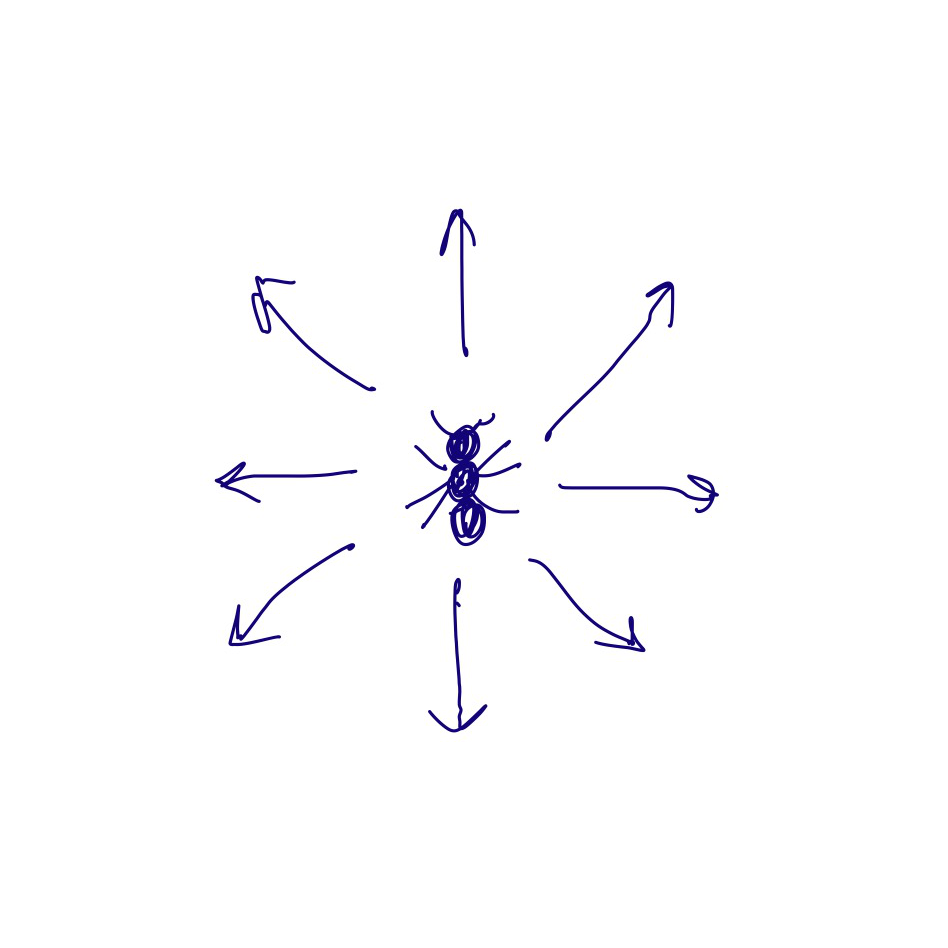Game: Ant Colony Tycoon Deluxe
Control an ant colony by placing pheromone trails on the ground that ants follow. Made for Ludum Dare 56.

You can also check out the game's Ludum Dare page, or the source code.
When we design games for game jams, we always discuss whether we should prefer the game to be experimental and innovative or stick to tried-and-true genres and tropes. The latter approach gave us Tower Tower Defence Defence, our most successful game to date, but I generally enjoy working on the weirder games more.
In that regard, I'm happy with how this game turned out. It strikes a good balance between being innovative and actually playable. The pheromone mechanism is satisfying and the ants shuffling around do seem realistic, but it still draws on familiar mechanics of collecting resources and infinite survival with increasing difficulty.
Initially, I was pushing for us to make a coding game inspired by cells and breaking symmetry in which you'd have to program identical units to coordinate and fulfill different roles – like having the units choose a "leader", or form themselves into a particular shape. We discarded that idea in the end because my teammates weren't excited about it and we thought the programming would be too complex; in hindsight it was indeed the right decision.
That left us with the vague idea of "control an ant colony using pheromones". On Saturday, we implemented the basic mechanics but we didn't really know how to turn the sandbox into an actual game. Then on Saturday the idea crystallized into what we ended up with. We borrowed the idea of the difficulty being controlled by zooming from Mini Motorways and later realized that there are a lot of parallels between the two games. They're both about managing a transport network on which many small units move and perform tasks.
The ant movement algorithm
The part I found technically most interesting was designing the ant movement algorithm. Here's the high-level idea.
The movement is divided into steps. In each step, the ant picks a target point and moves towards it. Once it reaches it, it picks a new target.
To pick a target, we first randomly pick a distance and then consider 36 possible targets that are all at the same distance and their angles are evenly spaced (0°, 10°, 20°, ...). For illustration, we'll pretend there are 8 possible targets instead:

We assign a score to each of these targets and then randomly choose one, with the probability being higher for targets with a higher score. There are two components to the score: a turning penalty and a pheromone reward.
Turning penalty
First, we penalize targets based on how different their angle is from the direction the ant is currently facing. That way, the ant will tend to keep on moving in the direction it's facing instead of doing a fully random walk. We subtract from each score, where is the angular distance in radians between the angle the ant is currently facing and the angle of the target. The factor is a parameter we can modify to make the turning penalty less or more important relative to the pheromone reward.

Pheromone reward
To nudge the ants to follow the pheromone trails, we add to each score the pheromone value at the target position.

Simple as that! But there are two technicalities here: one, the way the pheromone is represented internally doesn't fully match what the player sees. The pheromones shown to the player are spatially smooth and their values are discretized to five possible values. But under the hood, the grid is much coarser than pixel-level and the values can be any float from 0 to 1. We apply a shader to make this raw data pretty and then show it to the player.
The second technicality is that we actually add to the score. That way, lower values are emphasized and brought closer to the maximum value of 1. We added this to fix an issue where the ants would get stuck in a high-pheromone pool and had trouble getting out. Because ants carrying food produce pheromone, they were stuck in a feedback loop that kept refilling the pool. This way, it's easier for ants to decide to go to a place even if its pheromone value is not as high.
Putting it together
This way, we get a score for each target. These scores can be negative so we cannot directly use them sampling weights. To fix this, we use common trick from machine learning: we apply softmax to convert the scores into probabilities.
An advantage of softmax is that we can use a temperature parameter. A high temperature levels out the probabilities, meaning the ants are more likely to choose targets with lower scores. With a temperature of 0, they would always choose the target with the highest score.
By varying the temperature and the turning penalty , we get good control of the behavior of the ants and we can easily change it to balance the game.